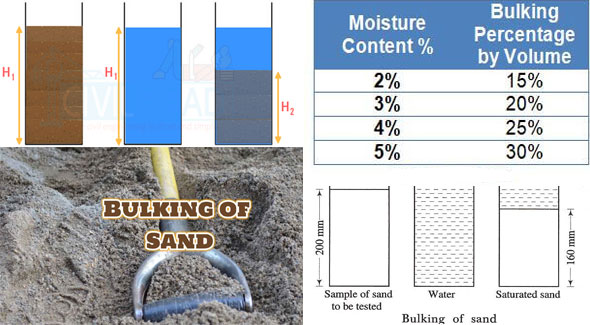How to calculate bulking of sand
- Concrete Cost Estimator
- Concrete Continuous Footing
- Landscape Bidding and Estimating
- Construction Cost Estimating
- Concrete and steel cost estimation
- Construction Cost Estimate Breakdown
- Construction Estimating Worksheet
- Home Construction Cost Estimate
- Estimate Pricing Sheet
- Sheet for General Contractor
- Construction Cost Estimate
- Labor Materials Cost Estimator
- Masonry Estimating Sheet
- Sheet for Building Contractor
- Construction Schedule Bar chart
- General Cost Estimator Sheet
- General Construction Estimate
- Building and Road Estimating Sheet
- Detailed expense estimates
- Door and Window Takeoff Sheet
- General Construction Cost Estimating Sheet

If dry sand comes in contact with the atmospheric moisture, bulking in sand happens. If moisture content exists, a thin layer is developed around sand particles.
This layer produces the force to shift particles a side each other. It leads to increasing the volume of sand.
If too much moisture content is present in the sand, the functionality of concrete is raised but the strength and longevity of concrete is reduced significantly.
According to IS code, existence of 4% of moisture content in sand enhances 25% of its volume.
The expanse of sand bulking is based on the grading of sand. Finer sand has more bulking as compared to the medium and coarse sand. Therefore, bulking in sand is greater for fine sand and less for coarse sand. If bulking is raised in sand, concrete mix is affected and behaves roughly at the time of placement.
Moisture content under 5% is recommended for construction purposes.
To work out the bulking of sand, percentage of moisture content in the sand, some water is added to raise the moisture content of sand. Because of this, the sand particles stuff nearer to each other and the bulking of sand is reduced slowly. So, it allows for determining the genuine volume of sand (dry sand). Therefore, the dry sand and completely saturated sand contains the same volume.
With the help of following procedure, percentage of bulking is obtained:-
1. Choose a simple container and include 2/3 part of sand in it.
2. Calculate the perfect height of sand with the scale and note it down. (H1)
3. Now pack the container upto 2/3 part with water. (similar height of sand)
4. Now include the measured sand to the container and wait for some time to settle down.
5. Now compute the height of Sand in water. (H2)
Article Source: civilread.com

- Application of concrete calculator
- Roofing Calculator can streamline the roof estimating process
- House construction cost calculator
- Engineering column design excel spreadsheet
- Material Estimating Sheet with Excel
- Materials List and Cost Estimate Worksheet
- Concrete Slab Estimating Calculator Sheet
- Common types of foundations for buildings
- Online calculation of construction materials
- Estimating with Excel for the Small Contractor
- Concrete Beam Design Spreadsheet
- Virtual Construction Management app for construction
- Autodesk’s Project Skyscraper
- Reed Construction’s Reed Insight
- Manage your construction project documentation
- Costimator, the popular cost estimating software
- On Center Software for construction professionals
- Free Construction Estimating Software
- Plumbing Calc Pro
- Cost Estimate Worksheet
- HVAC Piping Quantity Takeoff Worksheet
- Construction Estimating Software Sheet
- Estimate Cost Templates
- Construction Punch List
- Construction cost estimating template consisting estimating basic
- Gantt Chart Template for Excel
- Download Civil Engineering Spreadsheets with Verification
- The Building Advisor Estimating and Budgeting Worksheet
- Spreadsheet for design of concrete bridge
- Construction Estimating Software Free








